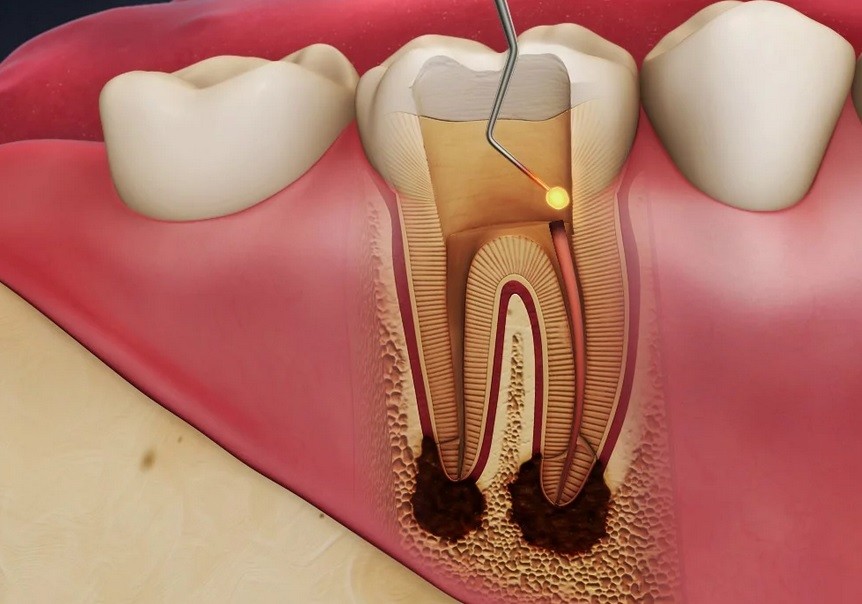Endodontics
Endodontics – what is it?

Endodontics – indications and contraindications
Indications
Contraindications
Endodontic treatment may be carried out in all teeth in which root canals have been infected. The symptom of such an infection is usually acute pain, especially intensifying under the influence of cold dishes or drinks. If these symptoms are ignored, the pain may slowly regress spontaneously, intensifying with warm dishes. Sometimes an unpleasant odor appears. This is not a sign of self-curing, on the contrary – it is evidence of pulp necrosis and is an absolute indication for root canal treatment. Endodontics is the last resort to removing a tooth. Negligence of treatment leads to irreversible changes in the bone surrounding the roots of the teeth and then only the extraction remains.
Endodontic treatment is not always recommended, especially when the channels are excessively narrowed (we call it obliteration) or the root is cracked longitudinally. A contraindication is also the significant destruction of the tooth, when its maintenance in the mouth is doubtful, a high degree of looseness or pathological changes in the bone surrounding the roots. Root canal treatment is not recommended in patients with undergoing immunosuppression (eg after transplantation) as well as in some heart conditions. The final decision is always made by the dentist in consultation with the physician administering the patient.
All the above situations are an indication for surgical treatment. In the case of single-rooted teeth, the only option is extraction, while in multi-root teeth, it is possible to remove only the infected root or its fragment, leaving the larger part of the tooth if it does not show any pathological changes. Sometimes in the lower molar teeth you can perform the so-called premolarisation – “cutting the tooth in half”, to thoroughly clean the space between the roots. Such 2 new teeth, well-endodontically treated and rebuilt, can still function in the oral cavity for a long time.
Endodontics – types of treatments
The treatment starts with providing comfort to the patient and the doctor, and therefore local anesthesia is performed, followed by the use of a cofferdam. The use of rubber dam in endodontics is necessary for several reasons. It not only facilitates the doctor’s work, but also prevents small, precise canal tools from falling into the mouth and throat of the patient, and protects the mucous membrane against irritation by disinfectants used to rinse channels. After this preparation of the patient, the doctor cleans the cavity to gain initial access to the channels, and then sets the treatment microscope over the treated tooth. From this moment, the treatment is carried out at an enlarged scale, thanks to which the endodontist finds all the canals without any problems and proceeds to their purification and elaboration. A qualified dental assistant cooperates with the doctor all the time, which allows him to work with the microscope continuously and guarantees exceptional precision and accuracy of the procedure.
Depending on the physician’s decision, temporary or final filling is used. The channels are finally filled with the best available material – biologically compatible liquid gutta-percha, which is introduced using a special dispenser (“gun”) and ensures an extremely tight filling. In the case of temporary filling, another visit is required to check and execute the final filling.
During endodontic therapy, X-ray examinations are necessary, which allow first to assess the number and course of the canals, and then verify the correctness of the performed procedure (tight filling of all channels). Photographs are taken in our clinic, maintaining the highest safety standards and using the latest equipment (so-called digital radiovisiography), which allows us to get pictures in excellent quality with the minimum radiation dose (for comparison – the dose affecting the patient during 1 x-ray image corresponds to the amount radiation that each of us receives naturally during the week – so-called background radiation, completely harmless to health).
Endodontics – frequently asked questions (FAQ)
Pricing
| Endodontic consultation (deducted from the cost of the visit) | 200PLN |
| Endodontic treatment of a milk tooth | Starting at 300 PLN |
| Root canal treatment using a microscope incisors | Starting at 1000 PLN |
| Root canal treatment using a microscope premolar tooth | Starting at 1300 PLN |
| Root canal treatment using a microscope molar tooth | Starting at 1600 PLN |
| Root canal treatment using a microscope 4-channel molar tooth | Starting at 1800 PLN |
| Removal of a root-crown inlay from the tooth | Starting at 300 PLN |
| Closure of the canal perforation with MTA | 300 PLN |
